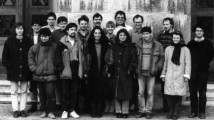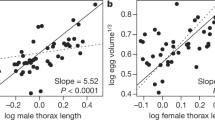Abstract
The empirical study of the role of sperm competition in the evolution of sexual traits has historically been problematic through the inability either to measure sperm competition levels directly in the present or to reconstruct changes in the evolutionary past. Here, we develop and test a procedure based on paternity data that potentially permits both. For our pilot study, we use the rate of change of the seminal protein gene SEMG2 for catarrhine primates published by Dorus et al. (Nat Genet 36:1326–1329, 2004). From their data, Dorus et al. proposed a two-part hypothesis: (1) sperm competition plays a role in the evolution of the SEMG2 gene and (2) higher levels of sperm competition generate more positive selection for change in SEMG2 than lower levels. Dorus et al. were limited, however, by being able to use only proxy measures of sperm competition and only seven “recent” segments of catarrhine primate phylogeny. Here, we develop a “timeline procedure” that permits the Dorus hypothesis to be tested using data from across the whole of catarrhine phylogeny. Our analysis supports part (1) of the Dorus hypothesis but questions part (2), suggesting instead that changes in level of sperm competition have a more powerful influence on the rate of evolution of traits than the level of sperm competition itself. We conclude that the timeline procedure developed here could be a valuable investigative tool in the role of sperm competition in the evolution of sexual traits measured over evolutionary time such as SEMG2.
Significance statement
The empirical study of the role of sperm competition in the evolution of sexual traits has historically been problematic through the inability to measure sperm competition levels directly in the present and to reconstruct changes in the evolutionary past. Here, we test a “timeline procedure” based on paternity data that potentially permits both. For our pilot study, we use the rate of change of the seminal protein gene SEMG2 for catarrhine primates published by Dorus et al. (Nat Genet 36:1326–1329, 2004). Whereas Dorus et al. were limited to using proxy measures for only “recent” segments of catarrhine primate phylogeny, our method permits direct measures of sperm competition to be applied across the whole of Catarrhine phylogeny. We conclude that this new procedure could be valuable for investigation of the role of sperm competition in the evolution of a wide range of sexual traits.



Similar content being viewed by others
References
Anderson MJ, Dixson AF (2002) Sperm competition: motility and the midpiece in primates. Nature 416:496–496. https://doi.org/10.1038/416496a
Arnold C, Matthews LJ, Nunn CL (2010) The 10kTrees website: a new online resource for primate phylogeny. Evol Anthropol 19:114–118. https://doi.org/10.1002/evan.20251
Baker RR, Shackelford TK (2018a) A comparison of paternity data and relative testes size as measures of level of sperm competition in the Hominoidea. Am J Phys Anthropol 16:421–443. https://doi.org/10.1002/ajpa.23360
Baker RR, Shackelford TK (2018b) Paternity data and relative testes size as measures of level of sperm competition in the Cercopithecoidea. Am J Primatol 80:e22937. https://doi.org/10.1002/ajp.22937
Cohen J, Cohen P (1983) Applied multiple regression/correlation analysis for the behavioral sciences. Erlbaum, Hillsdale
Dixson AF, Anderson MJ (2002) Sexual selection, seminal coagulation and copulatory plug formation in primates. Folia Primatol 73:63–69. https://doi.org/10.1159/000064784
Dorus S, Evans PD, Wyckoff GJ, Choi SS, Lahn BT (2004) Rate of molecular evolution of the seminal protein gene SEMG2 correlates with levels of female promiscuity. Nat Genet 36:1326–1329. https://doi.org/10.1038/ng1471
Eberhard W (1996) Female control: sexual selection by cryptic female choice. Princeton University Press, Princeton
Felsenstein J (1985) Phylogenies and the comparative method. Am Nat 125:1–15. https://doi.org/10.1086/284325
Good JM, Wiebe V, Albert FW, Burbano HA, Kircher M, Green RE, Halbwax M, André C, Atencia R, Fischer A, Pääbo S (2013) Comparative population genomics of the ejaculate in humans and the great apes. Mol Biol Evol 30:964–976. https://doi.org/10.1093/molbev/mst005
Hiller M, Schaar BT, Indjeian VB, Kingsley DM, Hagey LR, Bejerano G (2012) A “forward genomics” approach links genotype to phenotype using independent phenotypic losses among related species. Cell Rep 2:817–823. https://doi.org/10.1016/j.celrep.2012.08.032
Hu Z, Sackton TB, Edwards SV, Liu JS (2019) Bayesian detection of convergent rate changes of conserved noncoding elements on phylogenetic trees. Mol Biol Evol 36:1086–1100. https://doi.org/10.1093/molbev/msz049
Hurle B, Swanson W, Green ED, Comparative Sequencing Program NISC (2007) Comparative sequence analyses reveal rapid and divergent evolutionary changes of the WFDC locus in the primate lineage. Genome Res 17:276–286. https://doi.org/10.1101/gr.6004607
Kowalczyk A, Meyer WK, Partha R, Mao W, Clark NL, Chikina M (2018) RERconverge: an R package for associating evolutionary rates with convergent traits. bioRxiv, 451138. https://doi.org/10.1101/451138
Lartillot N, Poujol R (2011) A phylogenetic model for investigating correlated evolution of substitution rates and continuous phenotypic characters. Mol Biol Evol 28:729–744. https://doi.org/10.1093/molbev/msq244
Lee IA, Preacher KJ (2013) Calculation for the test of the difference between two dependent correlations with one variable in common [computer software], http://quantpsy.org
Lüpold S, Pitnick S (2018) Sperm form and function: what do we know about the role of sexual selection? Reproduction 155:R229–R243. https://doi.org/10.1530/REP-17-0536
Lutzoni F, Pagel M, Reeb V (2001) Major fungal lineages are derived from lichen symbiotic ancestors. Nature 411:937–940. https://doi.org/10.1038/35082053
Pagel M, Lutzoni F (2002) Accounting for phylogenetic uncertainty in comparative studies of evolution and adaptation. In: Lässig M, Valleriani A (eds) Biological evolution and statistical physics. Springer-Verlag, Berlin, pp 148–161
Pagel M, Meade A (2017) BayesTraits, www.evolution.rdg.ac.uk/BayesTraitsV3.0.1/BayesTraitsV3.0.1.html
Pagel M, Mead A, Barker D (2004) Bayesian estimation of ancestral character states on phylogenies. Syst Biol 53:673–684. https://doi.org/10.1080/10635150490522232
Parker GA (1970) Sperm competition and its evolutionary consequences in the insects. Biol Rev 45:525–567. https://doi.org/10.1111/j.1469-185X.1970.tb01176.x
Parker GA (2016) The evolution of expenditure on testes. J Zool 242:3–19. https://doi.org/10.1111/jzo.12297
Preacher KJ (2002) Calculation for the test of the difference between two independent correlation coefficients, http://quantpsy.org
Raftery AE (1996) Hypothesis testing and model selection. In: Gilks WR, Richardson S, Spiegelhalter DJ (eds) Markov chain Monte Carlo in practice. Chapman and Hall, London, pp 163–188
Rice WD, Gaines SD (1994) ‘Heads I win, tails you lose’: testing directional alternative hypotheses in ecological and evolutionary research. Trends Ecol Evol 9:235–237. https://doi.org/10.1016/0169-5347(94)90258-5
Ringle CM, Wende S, Becker JM (2015) SmartPLS 3. SmartPLS GmbH, Boenningstedt
Robert M, Gagnon C (1999) Semenogelin I: a coagulum forming, multifunctional seminal vesicle protein. Cell Mol Life Sci 55:944–960. https://doi.org/10.1007/s000180050346
Short RV (1979) Sexual selection and its component parts, somatic and genital selection, as illustrated by man and the great apes. Adv Stud Behav 9:131–158. https://doi.org/10.1016/S0065-3454(08)60035-2
Smith RL (ed) (1984) Sperm competition and the evolution of animal mating systems. Academic Press, London
Steiger JH (1980) Tests for comparing elements of a correlation matrix. Psychol Bull 87:245–251. https://doi.org/10.1037/0033-2909.87.2.245
Wong A (2010) Testing the effects of mating system variation on rates of molecular evolution in primates. Evolution 64:2779–2785. https://doi.org/10.1111/j.1558-5646.2010.01038.x
Wong A (2014) Covariance between testes size and substitution rates in primates. Mol Biol Evol 31:1432–1436. https://doi.org/10.1093/molbev/msu091
Yang Z (1998) Likelihood ratio tests for detecting positive selection and application to primate lysozyme evolution. Mol Biol Evol 15:568–573. https://doi.org/10.1093/oxfordjournals.molbev.a025957
Zaiontz C (2018) Real statistics using Excel, www.real-statistics.com
Acknowledgments
We thank Holger Herlyn for many helpful suggestions for the improvement of our manuscript. We also thank an anonymous reviewer for an extensive and detailed review of our original submission. It was an example of constructive reviewing at its best, and our paper is stronger and better organized as a result.
Author information
Authors and Affiliations
Corresponding author
Ethics declarations
Conflict of interest
The authors declare that they have no conflicts of interest.
Ethical approval
As all data for catarrhines used here are from published studies by other authors, the protocol and procedures did not require review and approval by the IACUC or other institutional ethics committees overseeing the use of humans or other animals in research in either the USA or the UK. The study also adhered to the American Society of Primatologists Principles for the Ethical Treatment of Non-Human Primates.
Informed consent/consent to participate
Informed consent is not relevant to this article.
Consent for publication
Not applicable
Data availability
All data generated or analyzed for this study are included in this published article and its supplementary information file.
Code availability
Not applicable
Additional information
Communicated by E. Huchard
Publisher’s note
Springer Nature remains neutral with regard to jurisdictional claims in published maps and institutional affiliations.
Electronic supplementary material
ESM 1
(PDF 307 kb)
Rights and permissions
About this article
Cite this article
Baker, R.R., Shackelford, T.K. The development, evaluation, and illustration of a timeline procedure for testing the role of sperm competition in the evolution of sexual traits using paternity data. Behav Ecol Sociobiol 74, 106 (2020). https://doi.org/10.1007/s00265-020-02889-y
Received:
Revised:
Accepted:
Published:
DOI: https://doi.org/10.1007/s00265-020-02889-y




